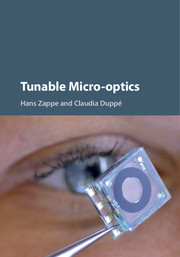Book contents
- Frontmatter
- Dedication
- Contents
- List of contributors
- List of acronyms
- Part I Introduction
- Part II Devices and materials
- Part III Systems and Applications
- 11 Characterization of Micro-optics
- 12 Photonic Crystals
- 13 MEMS Scanners for OCT Applications
- 14 Liquid Crystal Elastomer Micro-optics
- 15 Adaptive Scanning Micro-eye
- 16 Hyperspectral Eye
- 17 Plenoptic Cameras
- Index
- References
15 - Adaptive Scanning Micro-eye
from Part III - Systems and Applications
Published online by Cambridge University Press: 05 December 2015
- Frontmatter
- Dedication
- Contents
- List of contributors
- List of acronyms
- Part I Introduction
- Part II Devices and materials
- Part III Systems and Applications
- 11 Characterization of Micro-optics
- 12 Photonic Crystals
- 13 MEMS Scanners for OCT Applications
- 14 Liquid Crystal Elastomer Micro-optics
- 15 Adaptive Scanning Micro-eye
- 16 Hyperspectral Eye
- 17 Plenoptic Cameras
- Index
- References
Summary
Introduction
Over millions of years, evolution drove mammals to adapt to their natural habitat with a perfection and efficiency that is hard to beat. The human eye is one of the most accomplished examples even though – speaking from an optical engineering perspective – mammal eyes are of rather poor optical quality. Still, the vision of mammals is one of the most highly developed senses. This is not simply because the brain works associatively by comparing information to recorded data. Chief factor is the dynamical optical adaptability of the eye as such. This adaptability goes far beyond the mere tuning of the focal length to adjust to specific object distances. The human eye compensates for its shortcoming in achieving high resolution imaging only in a small field of view by constantly scanning and adapting to specific areas in a much larger volume in the object space. In order to build a technical model of a human eye, various dynamic functionalities such as focal length tuning, adaptation of the pupil diameter, as well as scanning have to be integrated.
We present an adaptive scanning imaging system which imitates the complex functions of the human eye. Our technical model comprises microlenses with variable focal length, highly dynamic variable filters and microirises, as well as micro-prisms with variable angles of deflection. The purely electric actuation is meant to reduce the overall size and retain a similar functionality as the biological model.
In Chapter 9, we introduced nanocrystalline aluminumnitride (AlN) and diamond (NCD) as completely new materials for tunable optics. In this chapter, we focus on integration schemes for AlN-based optical components and modules with tunable optical performance for the implementation of the complex functionality of an adaptive scanning micro-eye. In Section 15.2 we present the optical design of our tunable micro-eye and derive the most important features necessary for realizing the desired complex performance. Here, the chief challenge is to adapt the optical design to the performance that is feasible with the available technologies. Sections 15.3 to 15.5 discuss the performance of the individual optical elements with regard to focal length tuning, scanning, aperture stop variation, and dynamic wavefront correction. Various approaches towards the integration of the individual elements are discussed in Section 15.6. We evaluate the performance of submodules for various applications and we present a highly compact tunable scanning micro-eye, the final outcome of our research effort.
- Type
- Chapter
- Information
- Tunable Micro-optics , pp. 369 - 394Publisher: Cambridge University PressPrint publication year: 2015
References
- 2
- Cited by

